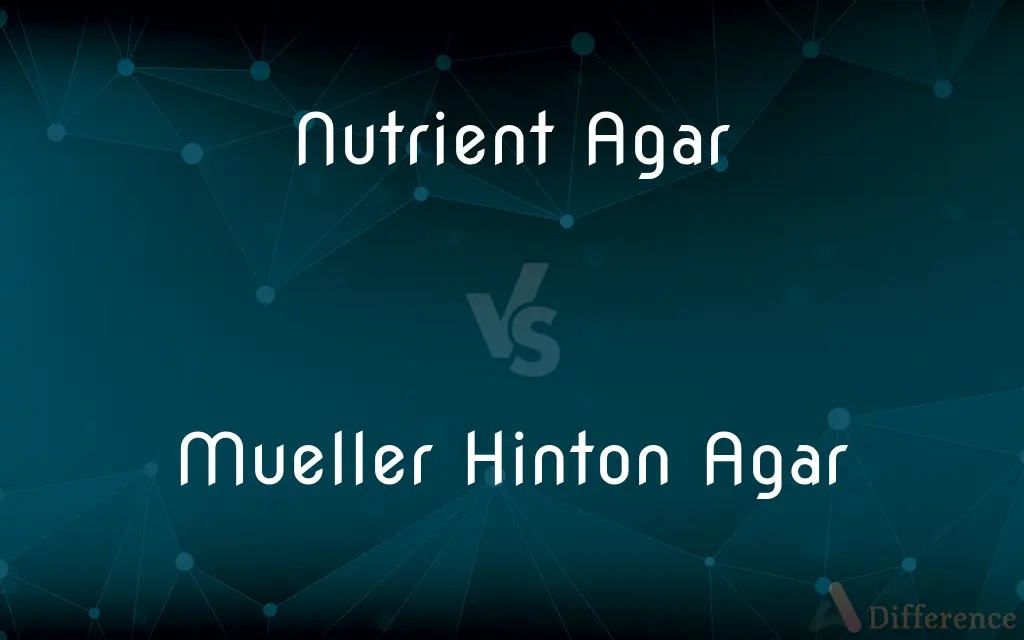Nutrient Agar vs. Mueller Hinton Agar — What's the Difference?
Edited by Tayyaba Rehman — By Fiza Rafique — Published on February 27, 2024
Nutrient Agar is a general-purpose medium supporting the growth of a wide range of non-fastidious organisms, while Mueller Hinton Agar is specialized for antibiotic susceptibility testing due to its controlled composition and pH.

Difference Between Nutrient Agar and Mueller Hinton Agar
Table of Contents
ADVERTISEMENT
Key Differences
Nutrient Agar (NA) is widely used in microbiology for the cultivation of various microorganisms, thanks to its simple, non-selective formula that provides essential nutrients for bacterial growth. It consists of peptone, beef extract, and agar. This medium is ideal for observing colony morphology, pure culture maintenance, and performing simple biochemical tests.
Mueller Hinton Agar (MHA), on the other hand, is specifically formulated to provide a standardized medium for antimicrobial susceptibility testing. Its composition includes beef infusion, casein hydrolysate, starch, and agar. The starch in MHA absorbs toxins released by bacteria, ensuring more accurate antibiotic testing results. MHA's consistent pH and controlled nutrient levels reduce the variation in antibiotic diffusion rates, making it the medium of choice for Kirby-Bauer disk diffusion tests.
Both NA and MHA serve as culture mediums, their applications diverge significantly. But NA's broad nutrient profile supports a wide variety of bacteria, making it suitable for general culturing purposes. MHA's precise formulation and inclusion of starch, however, cater specifically to the needs of antibiotic efficacy testing, ensuring that factors like pH and nutrient concentration do not interfere with the results.
The choice between Nutrient Agar and Mueller Hinton Agar depends largely on the laboratory procedure at hand. For general bacterial culture and maintenance, NA is preferred for its versatility and ease of use. For antibiotic sensitivity testing, MHA is indispensable due to its standardized composition that ensures reproducible results.
Comparison Chart
Purpose
General culturing of non-fastidious organisms
Antibiotic susceptibility testing
ADVERTISEMENT
Composition
Peptone, beef extract, agar
Beef infusion, casein hydrolysate, starch, agar
Special Ingredient
None
Starch (to absorb toxins)
PH
Broadly suitable for growth
Controlled for susceptibility testing
Applications
Colony morphology, pure culture maintenance, biochemical testing
Kirby-Bauer disk diffusion test, antibiotic efficacy testing
Compare with Definitions
Nutrient Agar
Used for maintaining pure cultures in the lab.
A pure culture of Bacillus subtilis was stored on Nutrient Agar slants.
Mueller Hinton Agar
Standardized medium ensures reproducible results.
Consistency in Mueller Hinton Agar composition is critical for the Kirby-Bauer test.
Nutrient Agar
Supports the growth of non-fastidious organisms.
Staphylococcus aureus was cultured on Nutrient Agar for a classroom demonstration.
Mueller Hinton Agar
Controlled pH and nutrient levels for precise testing.
The controlled environment in Mueller Hinton Agar is essential for evaluating antibiotic effectiveness.
Nutrient Agar
A general-purpose medium for growing a wide range of bacteria.
Nutrient Agar was used to culture E. coli for a genetics experiment.
Mueller Hinton Agar
Preferred for Kirby-Bauer disk diffusion tests.
Antibiotic resistance patterns were assessed using Mueller Hinton Agar plates.
Nutrient Agar
Ideal for observing colony morphology.
Different bacterial colonies were compared on Nutrient Agar plates.
Mueller Hinton Agar
Contains starch to absorb bacterial toxins.
The starch in Mueller Hinton Agar ensures accurate results in susceptibility tests.
Nutrient Agar
Simple and versatile for basic microbiological applications.
Nutrient Agar served as the medium for a series of antibiotic production tests.
Mueller Hinton Agar
Specialized for antibiotic susceptibility testing.
Mueller Hinton Agar was used to determine the sensitivity of a bacterial strain to various antibiotics.
Common Curiosities
What makes Mueller Hinton Agar unique?
Its inclusion of starch to absorb bacterial toxins and its controlled physical and chemical properties make it ideal for evaluating the efficacy of antibiotics.
What is Nutrient Agar primarily used for?
Nutrient Agar is used for the general cultivation of a wide variety of non-fastidious microorganisms.
Why is Mueller Hinton Agar preferred for antibiotic susceptibility testing?
Its controlled composition, including starch, pH, and nutrient levels, provides a standardized environment for accurate antibiotic susceptibility testing.
Can I use Mueller Hinton Agar for general bacterial culture?
While it can be used for general culturing, its specific formulation and higher cost make it less practical for non-testing purposes.
Why is the pH of Mueller Hinton Agar controlled?
A controlled pH is critical for consistent antibiotic diffusion rates, which is essential for accurate susceptibility testing.
Is Nutrient Agar suitable for growing all types of bacteria?
Nutrient Agar is suitable for a broad range of non-fastidious organisms but may not support the growth of more fastidious bacteria.
How does the starch in Mueller Hinton Agar affect antibiotic testing?
Starch absorbs toxins that could interfere with antibiotic activity, ensuring a more accurate assessment of antibiotic effectiveness.
Can I use Nutrient Agar for antibiotic susceptibility testing?
While possible for preliminary assessments, Nutrient Agar is not recommended for standardized antibiotic susceptibility testing due to its non-standardized composition.
What is the difference in the nutritional composition between Nutrient Agar and Mueller Hinton Agar?
Nutrient Agar contains simple, general-purpose nutrients, while Mueller Hinton Agar's composition is specifically designed and controlled for antibiotic testing.
Can fastidious bacteria be grown on Nutrient Agar or Mueller Hinton Agar?
Fastidious bacteria typically require more specialized media with additional nutrients or growth factors not present in standard Nutrient Agar or Mueller Hinton Agar formulations.
Share Your Discovery

Previous Comparison
New York Jets vs. Pittsburgh Steelers
Next Comparison
Newtonian Telescope vs. Cassegrain TelescopeAuthor Spotlight
Written by
Fiza RafiqueFiza Rafique is a skilled content writer at AskDifference.com, where she meticulously refines and enhances written pieces. Drawing from her vast editorial expertise, Fiza ensures clarity, accuracy, and precision in every article. Passionate about language, she continually seeks to elevate the quality of content for readers worldwide.
Edited by
Tayyaba RehmanTayyaba Rehman is a distinguished writer, currently serving as a primary contributor to askdifference.com. As a researcher in semantics and etymology, Tayyaba's passion for the complexity of languages and their distinctions has found a perfect home on the platform. Tayyaba delves into the intricacies of language, distinguishing between commonly confused words and phrases, thereby providing clarity for readers worldwide.
















































